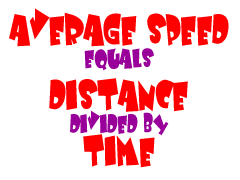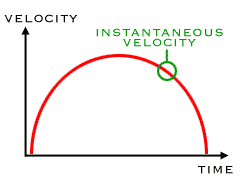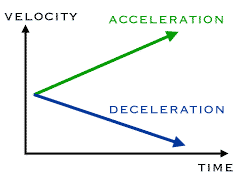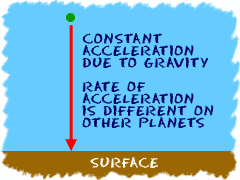Velocity, Speed, and Motion... Oh My!
 Velocity and speed are very similar ideas, but velocity is a vector,
and speed is not. Suppose we knew that someone was driving at
thirty-five kilometers an hour (35 km/hr), but the direction wasn't
given. How would you draw an arrow to represent a vector? You can't know
how to draw the vector if you only have one value (either amount or
direction). In this example, you were never told about the direction.
Physicists would say that the speed is thirty-five kilometers an hour
(35 km/hr), but the velocity is unknown. On the other hand, if you're
moving at 35 km/hr in a northern direction, then you would have an arrow
pointing north with a length of 35. Physicists would say that the
velocity is 35 km/hr north.
Velocity and speed are very similar ideas, but velocity is a vector,
and speed is not. Suppose we knew that someone was driving at
thirty-five kilometers an hour (35 km/hr), but the direction wasn't
given. How would you draw an arrow to represent a vector? You can't know
how to draw the vector if you only have one value (either amount or
direction). In this example, you were never told about the direction.
Physicists would say that the speed is thirty-five kilometers an hour
(35 km/hr), but the velocity is unknown. On the other hand, if you're
moving at 35 km/hr in a northern direction, then you would have an arrow
pointing north with a length of 35. Physicists would say that the
velocity is 35 km/hr north.
Velocity is the rate of motion in a specific direction. I'm going that-a-way at 30 kilometers per hour. My velocity is 30 kilometers per hour that-a-way. Average speed is described as a measure of distance divided by time. Velocity can be constant, or it can change (acceleration). Speed with a direction is velocity.
Remember vectors? You will use a lot of vectors when you work with velocity. Our real world example of navigation on the ocean used velocity for every vector. Velocity is a vector measurement because it has an amount and a direction. Speed is only an amount (a scalar). Speed doesn't tell the whole story to a physicist. Think of it another way. If I tell you I'm driving north and ask you how long until we get to the city. You can't know the answer since you don't know my speed. You need both values.
One Moment in Time
 There is a special thing called instantaneous velocity.
That's the velocity at a split second in time. Above, we were talking
about your speed and direction over a long period of time. Why would you
need to measure a velocity at one moment? Think about the moment you
drove over the manhole. It's important to know if you were going 1 km/hr
when you drove over the manhole, or 60 km/hr. It wouldn't help you to
know that your average speed was 30 km/hr.
There is a special thing called instantaneous velocity.
That's the velocity at a split second in time. Above, we were talking
about your speed and direction over a long period of time. Why would you
need to measure a velocity at one moment? Think about the moment you
drove over the manhole. It's important to know if you were going 1 km/hr
when you drove over the manhole, or 60 km/hr. It wouldn't help you to
know that your average speed was 30 km/hr.
The term "instantaneous" refers to something physicists call a limit. Scientists "limit" the amount of time they do the measurement. When the "limit" moves to zero, that limit is one tiny moment in time. A physicist would measure your velocity as the "limit for a period of time", zero, to get the instantaneous velocity.
Changing Your Velocity
 When velocity is changing, the word acceleration is
used. Acceleration is also a vector. You speed up if the acceleration
and velocity point in the same direction. You slow down (also referred
to as decelerating) if the acceleration and velocity
point in opposite directions. When you accelerate or decelerate, you
change your velocity by a specific amount over a specific amount of
time.
When velocity is changing, the word acceleration is
used. Acceleration is also a vector. You speed up if the acceleration
and velocity point in the same direction. You slow down (also referred
to as decelerating) if the acceleration and velocity
point in opposite directions. When you accelerate or decelerate, you
change your velocity by a specific amount over a specific amount of
time.
Just as with velocity, there is something called instantaneous acceleration. Instantaneous means scientists measure your acceleration for a specific moment of time. That way they can say he was accelerating at exactly this amount at this point during his trip.
Constant Acceleration
 There are a few special situations where acceleration may be constant.
This type of acceleration happens when there is a constant net force
applied. The best example is gravity.
Gravity's pull on objects is a constant here on Earth and it always
pulls toward the center of the planet (Note: Gravity decreases as you
move far away from the surface of the planet.). The gravities of other
planets are different from Earth's gravity because they may have
different masses and/or sizes. Even though the gravity may be smaller or
larger, it will still create a constant acceleration near the surface
of each planet.
There are a few special situations where acceleration may be constant.
This type of acceleration happens when there is a constant net force
applied. The best example is gravity.
Gravity's pull on objects is a constant here on Earth and it always
pulls toward the center of the planet (Note: Gravity decreases as you
move far away from the surface of the planet.). The gravities of other
planets are different from Earth's gravity because they may have
different masses and/or sizes. Even though the gravity may be smaller or
larger, it will still create a constant acceleration near the surface
of each planet.